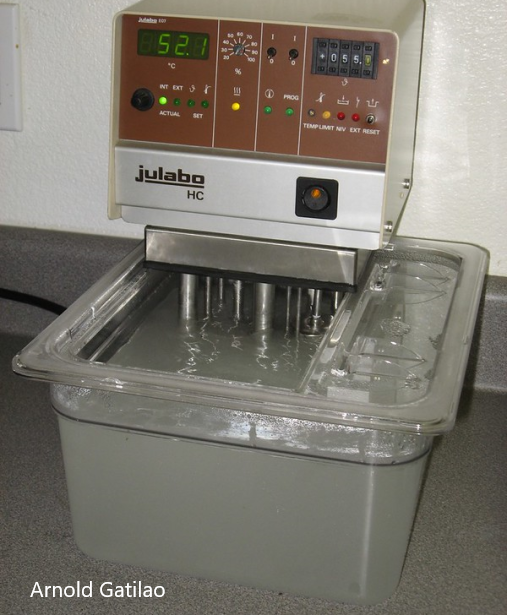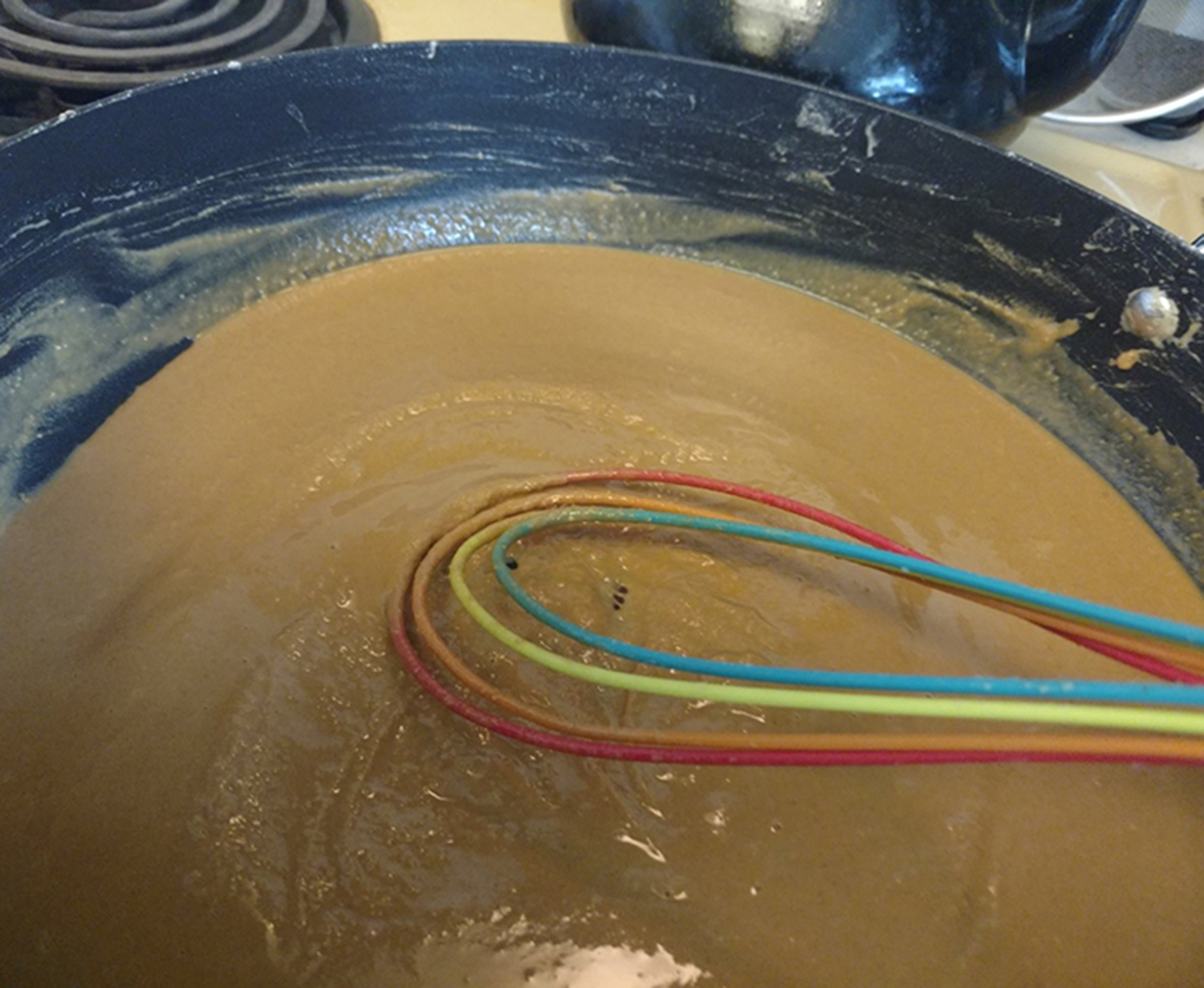QT 118 – Temper, Temper…Temper

Why hello there, and welcome back to Kitchen Catastrophe Quick Tips, where we quickly and quaintly unpack qulinary quriosities and questions. Today’s topic is “tempering”, since I mentioned it on Monday, don’t remember if I’ve talked about it before, and if “qulinary quriosities” didn’t tell you, I’m kind of on the last fumes in the tank vis a vis creativity. So we’re going to tell you how to tame your temper for tasty treats. (Alliteration and assonance are my ancient allies in avoiding inadequate articulation.)
Third Time’s the Charm
So, on Monday I specifically mentioned tempered CHOCOLATE, but it’s worth noting that there are multiple times you will “temper” foods. Specifically, there are three main times, each subtly different, but based on the same premise:
1.When you want to make smooth, lustrous chocolate that doesn’t melt in your hand, and SNAPS rather than ‘crunches’ when you bite it.
2. When you’re mixing a heated sauce or recipe with dairy products
3.When you’re mixing a heated sauce or recipe with eggs.
Why? Well, as the name might suggest, tempering has to do with temperature. (Though it does also require some anger management to do correctly.) In Chocolate, it’s a matter of crystallization, and in dairy and eggs, it’s a question of curdling. So let’s dive in and explain the hows and whys.
Egg on My Face
Even if you are a relatively novice home cook, you have probably heard or seen someone temper eggs, or talk about it. Tempering eggs is what you’re dealing with whenever someone says “Be careful here, you don’t want scrambled eggs in your (WHATEVER THEY’RE MAKING).”
Unless the thing they’re making is an omelet. Then that line has a different meaning.
You’ll often see this executed with someone taking a ladle of the hot soup/sauce/whatever, and stirring it with the eggs in another bowl, before mixing that back into the main dish. That’s a classic egg tempering technique. The REASON for the technique is, well, pretty much exactly what they said: see, when you use eggs as a thickening or enriching agent, what happens is that the proteins in the egg stretch out in heat (around 140 degrees Fahrenheit) meet other stretching proteins, and grab onto each other, forming a little protein net. IF you do it too fast/with too much heat (over 160 degrees), the proteins will grab each other, and pull each other in tight, forcing moisture out of the eggs, causing them to curdle and become rubbery.
But if you give the egg proteins plenty of space, they don’t lock up arms as tightly. This is why you add the ladle to the bowl of eggs: you’re diluting the eggs, so they have to stretch farther. If you really wanted to, you could test this by getting a pot of boiling chicken broth (212 degrees), and pouring a bowl of whisked eggs into it. You’d end up with a giant ball of (overcooked) scrambled egg, as the high heat of the water caused the outside edges of the eggs to set up. (For a more appetizing example: this is how you make egg drop/egg flower soup: get your soup to like, 150 degrees, stir it until it’s a little spinning whirlpool, and drizzle in eggs which will set into nice little ribbons.) According to experts, if you use a blender, you can actually skip the tempering step, as a blender should move a mixture fast enough that the eggs don’t have time to set, but I’d maybe play that one a little cautious the first few times.
I’m not doubting Sohla (the author of the piece), as I have full faith in everything she says about food. I’m just saying that I’m sure I would screw up and like, use too much hot liquid in too weak a blender or something.
Thus, by keeping the eggs in the temperature range they want to be in, you can ensure your sauces or soups are rich without getting strands of scrambled egg. (Unless you want them!) So that’s eggs sorted, what about dairy?
Milk it For All It’s Worth
You do the same thing with dairy for basically the same reason, even though you probably don’t think of it that way. See, because milk is already a much more water-based emulsion than eggs, it doesn’t really ‘set’ under heat. There’s not enough protein to cause the whole thing to congeal…maybe. (technically, I think if you simmered milk for long enough, you could cook off enough of the water to form a set block of dairy protein, but the fact that I’m unsure here suggests that either it can’t happen due to the different natures of milk and egg proteins, or there’s just no reason to ever do it: given the weird dishes and chemical/structural experimentations I DO know about, if a lot of chefs knew you could cook milk down into a weird milk-brick, I would have heard about it.) You can SCALD milk, which bring it quite close to its curdling point, and kills off certain enzymes and starts to mess with the protein structure of the milk. (Indeed, scalding milk is a necessary step for making certain breads, because they need the altered protein structure.), but you don’t really ‘set’ it. So it’s more a matter of “do you straight up curdle it?”
Like, I’ve made panna cotta, which is pretty close to “set brick of dairy”. If the same thing could be done without gelatin or egg, by just simmering milk for 2 hours, I should have heard about it.
Again, because of the different composition of milk, curdling produces weird effects in milk than in eggs, which basically just leak water. Milk will leak whey, an acidic protein-rich liquid, and create more of a grainy texture, since the balls of curdled milk proteins are much smaller than the respective ones of the eggs. (This, by the whey (heh), is what that nursery song was about: Little Miss Muffett was basically eating cottage cheese.)
You fix it with almost exactly the same points, though milk can afford to be added to a higher heat, which is why it comes up less often. Oh, that also reminds me: it should be obvious, based on the discussion, but you don’t need to temper if you’re not mixing cold with hot. If your soup, sauce, custard, or whatever base is still under say, 120 degrees, you don’t need to care about tempering. Also note that, while it would be unpleasant to drink, curdled milk isn’t, by definition, bad: indeed, you can’t make normal cheese without curdling milk, since the cheese making process is basically just taking a bunch of milk curds, and convincing them they’re all one BIG curd.
Just toss them in a sack and squeeze ‘em.
Alright, so that’s the Curd couple, what about Chocolate Diamonds over here?
Gaze into My Chocolate Crystal Ball
Chocolate’s issue is...slightly weirder. Specifically, it has to do with crystallization. A lot of foods are, or involve, crystallization. Salt, obviously, and sugar too. Honey crystallizes over time as its sugars form their crystals. Even like, bread crystallizes: bread becomes “stale” as its starches reform into crystals that are less appealing texturally. The starches only LEFT their crystal state because the bread was heated, and that’s why re-heating bread is a go-to way to fix bread that is starting to get a little stale. (though it has reduced effects, so you can’t just keep reheating a loaf to keep it ‘good’ forever.)
Eventually, this will just be a brick.
Chocolate, meanwhile, relies mostly on lipid (fat) crystallization. Specifically, Cocoa butter, the primary fat in REAL chocolate, has several crystalline states. This is actually part of the problem. See, Cocoa butter CAN crystallize into 6 different forms. But only one of them is tempered chocolate: form Five (or Form V, for my Roman readers), also known as “beta crystallization”, to scare off the toxic jock chocolatiers. It sets in at about 95 degrees F, which is why that kind of chocolate, while it will melt in your hand eventually, takes time to do so. So the goal is pretty simple: get those crystals to form, so the chocolate sets the right way. How do you achieve that? Well, that takes a little bit of work: See, what you’ve got to do is heat the chocolate to notably over 97 degrees (Most people aim for the 110-120 range, as that gives them more working room.) THEN, you need to cool the chocolate down to around 80 degrees, then bring it back up to around 90 degrees. Yes, you’ve got to hit three different temp targets. Why? Those ever present bastards of humanities student’s GPA: Math and physics Specifically, you’re stuck in an irritating range: as mentioned we want the Form V crystals or “beta” crystals. They form at around 94 degrees. But there are two other forms that crystallize at around the same temperatures: Form IV(4) form at around 80 degrees, while form VI (6) form at 97 degrees.
Though in England, Sixth Form emerges around age 17. Little English school org joke for you all.
So you’re trying to keep the chocolate in a ‘sweet spot’: above 97 degrees, no crystals form. Between 97 and 94 degrees, Form 6 crystals form. So you want to start above 97, then drop down to just above form 4 Stage to ‘flash freeze’ the crystals closer to the bottom of the range for Form 5. By then heating back up to around 90 degrees, you ensure that any parts of the chocolate that got too cold and started making form 4 crystals melt again and become Form 5s. You spend a little time there, to give the chocolate time to, on a microscopic level, all ‘get in line’. Then you pour the stuff into molds, and let it cool: since it’s (hopefully) almost all form 5 crystals by now, relatively few of the lower forms are created as the whole mass cools. IF that feels confusing, imagine the invisible crystals inside the molten chocolate as…self-creating jello. If you form at the wrong temp, you get too much or too little of the jello, so it’s either watery, to too rubbery. Or, even weirder/worse, you get it unevenly distributed, so you’ve got pockets of hard jello mixed in with the loose goo. Sometimes food is weird.
So to achieve this fergalicious up and down, and looking at its “uh”, there are a couple go-to methods. They’re all aiming to achieve the same results, with mixtures of methodology that rather conveniently slowly transition from “shorter time but more effort” to “longer time, but less effort.”
Marbletop
It’s not often that “smear things around on the table” is the FANCY solution to a problem. Though, now that I say that, that was like, the basis of a 3 Michelin Star dessert.
For small scale or old-school chocolatiers, they use the Marble slab method: a cool marble countertop or large workspace happens to absorb the heat from the chocolate in a distinct way that makes crystallization easier. If you ever see a fancy candy or chocolate place pouring molten chocolate onto a bare table, this is likely what they were doing. Once poured out, the chocolate is agitated and folded frequently, to minimize the number of Form 6 crystals that form as the mixture cools to the right temp. Do I expect you to smear a large marble countertop that’s clean enough that you’d be willing to smear hot chocolate on it and slap it around like a teppanyaki chef at a Benihana’s? No. But it DOES exist, so if you’re bougie enough to have the counters for it, go nuts.
Seeded
A classic example of “Yes, I swear this is working as intended.”
The Second, and more standard home cook method, is the “Seeding” method. Which is built on a very simple premise: when the good chocolate comes to you, it’s already tempered. It’s GOT the right crystals. And crystals like to grow on crystals. So, you take about 2/3rds of the chocolate you want to temper, and melt it down. Then, you take it off the heat, and toss in the remaining third, stirring to incorporate. The molten chocolate will melt the solid chocolate, losing its heat, and aligning itself with the existing crystal structure in the solid chocolate. This method is slower than the counter-top one (though vastly less messy), and does take a moderate amount of effort. And if you want to be extra bougie about this method, they do just straight up sell Form V beta crystals, which is how industrial grade operations do it: they just melt the chocolate to the right temp in a huge vat, and then dump in a bunch of the right crystals,
The Vide
Weirdly, not a lot of pictures of sous vide machines on Flickr. None with chocolate. SO enjoy this one, where Andrew assures us the water looks this bad because his wife used dirty tongs to get the bags out of the water.
The last option some of you have probably guessed when I mentioned that this was an operation that needed a relatively narrow/tight band of temperatures to function: it’s sous vide cooking. If you have a sous vide circulator or other sous vide device, you can dial in very specific temperatures for tempering, ensuring the mixture hits the right numbers before usage. There’s just one major problem with it: see, molten chocolate and water don’t get along. Water can and will cause chocolate to seize up (essentially the chocolate form of curdling). And sous vide is done in water baths. So if you take this method, be sure to dry your bag off THOROUGHLY before getting the chocolate out of it.
There is technically a fourth way: remember when I mentioned that, if you keep your mixture under 120 degrees, you don’t need to temper your eggs? Well, you can pull a similar thing with chocolate: if you slowly and gently melt your tempered chocolate, and it never goes above 94 degrees, it’ll keep its temper. You can do this with like, the sous vide, or a double boiler, or a microwave. It’ll take a while, and your chocolate will likely be a little harder to work with (since it’ll have melted less), but it can be done.
Now, are you going to need to temper chocolate as a home cook very often? Probably not: it’s mostly for directly making bars of chocolate, or firm chocolate coatings. It’s almost certainly only ever a special occasion process. But now you’ve got some options and ideas for how to do it, as well as some good tips for keeping your eggs and milk from setting and scrambling your recipes all the whey. I liked that series of puns, so I’m going to leave now.
MONDAY: IS A HOLIDAY, YOU JACKALS. BUT ASSUMING MY FAMILY DOESN’T DECIDE TO DO SOMETHING THAT DAY, I’LL SEE ABOUT GETTING SOMETHING UP. I FORGOT THAT I HAD A COUPLE DISHES PRE-COOKED, SO I COULD WRITE THOSE UP, BUT WE’LL SEE.
THURSDAY: HEAD EMPTY, NO THOUGHTS.














